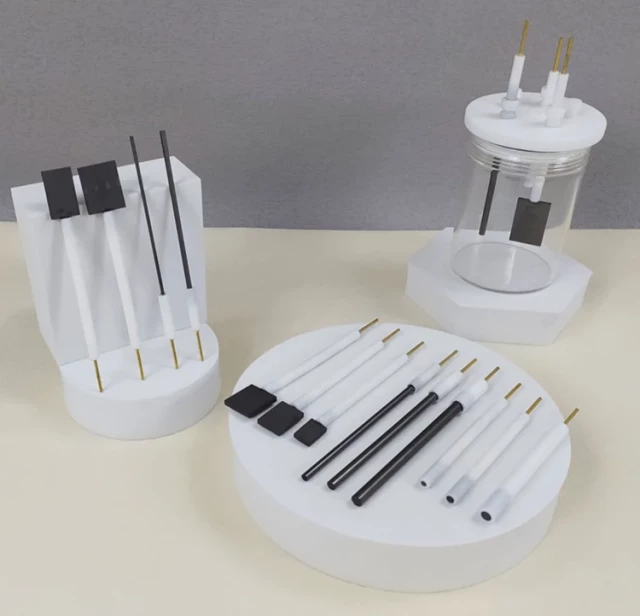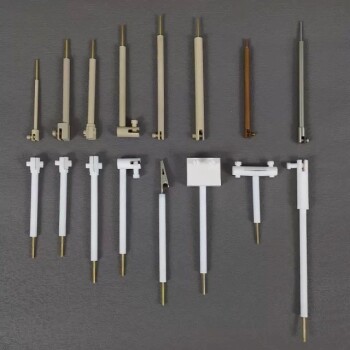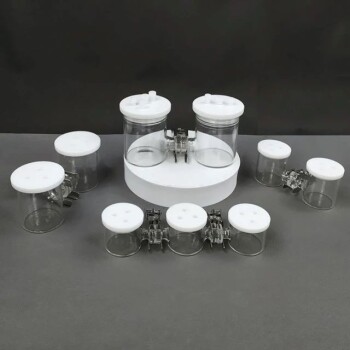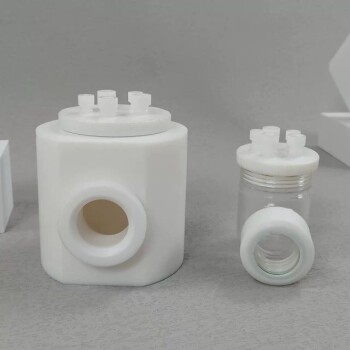Introduction to Reference Electrodes
Reference electrodes are an essential component in electrochemical measurements. They are used to establish a stable and reproducible potential for the working electrode and provide a reference point for the measurement. The reference electrode should have a stable and well-defined potential, which is independent of the solution's composition and the working electrode's potential. Common types of reference electrodes include the standard hydrogen electrode (SHE), the silver/silver chloride electrode (Ag/AgCl), and the saturated calomel electrode (SCE). The choice of reference electrode depends on the type of electrochemical measurement, the solution's composition, and the electrode's compatibility with the working electrode.
Table of Contents
- Introduction to Reference Electrodes
- Purpose of Reference Electrodes
- What are Pseudo-Reference Electrodes?
- Advantages of Pseudo-Reference Electrodes
- Considerations for Using Pseudo-Reference Electrodes
- When to Use Pseudo-Reference Electrodes
- How to Use Pseudo-Reference Electrodes
- Conclusion: Choosing the Right Reference Electrode
Purpose of Reference Electrodes
A reference electrode is an essential component in electrochemical measurements as it provides a stable potential against which all other potentials can be measured. The purpose of the reference electrode is to maintain a constant potential regardless of changes in the experimental conditions.
Components of Reference Electrodes
The typical reference electrode consists of an internal element, normally silver-silver chloride, surrounded by an electrolyte-containing filling solution (commonly KCl, saturated with AgCl) which is contained in either a glass or plastic body salt bridge, which terminates at the liquid junction. The internal element must remain wet and surrounded by the reference electrolyte filling solution.
Importance of Liquid Junctions
The liquid junction is an important aspect of a reference electrode as it provides contact with the sample through its liquid junction. The reference electrode achieves this by providing a constant and defined potential. This potential is determined by the electrolyte inside the electrode.
Types of Reference Electrodes
The most common aqueous reference electrodes used include the standard hydrogen electrode, normal hydrogen electrode, saturated calomel electrode, reversible hydrogen electrode, silver chloride electrode, copper-copper sulfate electrode, PH electrode, dynamic hydrogen electrode, and palladium-hydrogen electrode. The copper-sulfate reference electrodes have three advantages over other electrodes.
Selection of Reference Electrodes
To select the right reference electrode, the following factors must be considered:
- Compatible with the sample being measured
- Stable potential for an accurate measurement
- Fast response time to ensure analytical process efficiency
- Temperature considerations
- Chemical composition of the sample
What are Pseudo-Reference Electrodes?
In electrochemical experiments, reference electrodes are used to measure and control the potential of a working electrode. However, in some cases, a true reference electrode may not be available or may not function properly due to the working electrode's potential being too negative or positive. This is where pseudo-reference electrodes come in.
Definition of Pseudo-Reference Electrodes
Pseudo-reference electrodes are electrodes made from materials with a stable potential, such as silver or platinum, and are inserted into the electrolyte solution near the working electrode. They are called "pseudo" because they are not true reference electrodes, but rather electrodes that can be used as reference electrodes under certain conditions.
When to Use Pseudo-Reference Electrodes
Pseudo-reference electrodes can be used in situations where a true reference electrode is not available, or when the working electrode potential is too negative or positive for a traditional reference electrode to function properly. Additionally, they can be useful when working with non-aqueous or mixed solvent electrolytes that are not compatible with traditional reference electrodes.
Advantages and Disadvantages of Pseudo-Reference Electrodes
Pseudo-reference electrodes expand the range of experiments that can be performed with confidence, but it is important to note that they can introduce additional uncertainty and error into electrochemical measurements. Therefore, they should only be used when necessary and with careful consideration.
Conclusion
In summary, pseudo-reference electrodes are a valuable tool for electrochemical researchers that can be used in situations where traditional reference electrodes are not suitable. However, their use should be approached with caution to ensure accurate and reliable results.
Advantages of Pseudo-Reference Electrodes
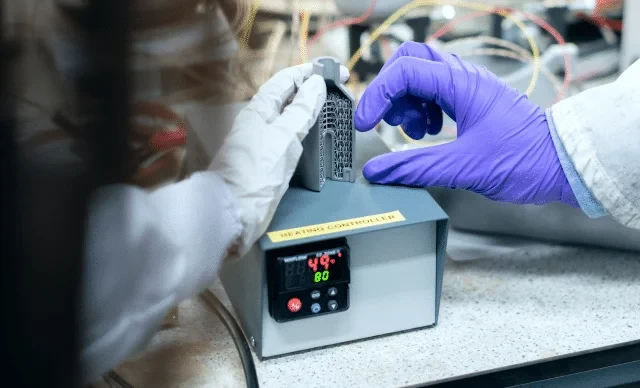
Pseudo-reference electrodes offer several advantages over traditional reference electrodes, which make them a valuable tool in electrochemistry. Here are some of the key advantages of using pseudo-reference electrodes:
Versatility
One of the main advantages of pseudo-reference electrodes is their versatility. Traditional reference electrodes are designed to work with specific types of samples, and their chemical composition can limit their use in certain applications. Pseudo-reference electrodes, on the other hand, can be used in a wide range of applications, including the measurement of biological samples, environmental samples, and even industrial materials. This versatility makes them a valuable tool for researchers who need to measure the electrochemical properties of a variety of different samples.
Easy Preparation
Another advantage of pseudo-reference electrodes is that they are easy to prepare. Traditional reference electrodes require careful preparation and maintenance to ensure accurate results. Pseudo-reference electrodes, on the other hand, can be prepared quickly and easily, which saves time and reduces the risk of error. This makes them a cost-effective alternative to traditional reference electrodes.
Low Maintenance
Pseudo-reference electrodes also require less maintenance than traditional reference electrodes. Traditional reference electrodes need to be recalibrated frequently, and their chemical composition can change over time, which can affect their accuracy. Pseudo-reference electrodes, on the other hand, do not require the same level of maintenance, which can save time and reduce costs.
Accurate Results
While pseudo-reference electrodes may not be suitable for all applications, they can provide accurate results in many cases. They are designed to mimic the functions of a traditional reference electrode, and their versatility and easy preparation make them a valuable tool for many researchers.
In conclusion, pseudo-reference electrodes offer several advantages over traditional reference electrodes. Their versatility, easy preparation, low maintenance, and ability to provide accurate results make them a valuable tool in electrochemistry. However, it is important to note that they may not be suitable for all applications, and careful consideration should be given to the sample being measured and the conditions under which the measurement is being performed.
Considerations for Using Pseudo-Reference Electrodes
When using a pseudo-reference electrode, there are several important considerations that need to be taken into account to ensure accurate and reliable measurements. Some of these considerations include:
Stability of the Pseudo-Reference Electrode Potential
One of the most important considerations when using a pseudo-reference electrode is the stability of its potential over time. The stability of the potential can be affected by factors such as temperature, pH, and the presence of interfering species. It is important to monitor the potential of the pseudo-reference electrode over time to ensure that it remains stable throughout the experiment.
Compatibility of the Pseudo-Reference Electrode with the Sample and Working Electrode
Another important consideration when using a pseudo-reference electrode is its compatibility with the sample and working electrode. Some materials may react with the sample or working electrode and affect the measurement results. It is important to choose a pseudo-reference electrode that is compatible with the specific application and materials being used.
Choice of Pseudo-Reference Electrode
The choice of pseudo-reference electrode is also an important consideration. Different types of electrodes may have different properties and limitations. It is important to choose the appropriate pseudo-reference electrode for the specific application to ensure accurate and reliable measurements.
Calibration of the Pseudo-Reference Electrode
Calibrating the pseudo-reference electrode is important to ensure that it is providing a stable reference potential for electrochemical measurements. Calibration should be performed before each experiment to ensure that the electrode is functioning properly and providing accurate and reliable measurements.
Maintenance of the Pseudo-Reference Electrode
Proper maintenance of the pseudo-reference electrode is also important to ensure accurate and reliable measurements. The electrode should be cleaned and stored properly to prevent contamination and ensure that it remains in good working condition.
In conclusion, using a pseudo-reference electrode can be a useful tool in electrochemical measurements when a stable reference electrode is not available or difficult to use. However, careful consideration of the potential sources of error and the specific requirements of the measurement setup is necessary to ensure accurate and reliable measurements.
When to Use Pseudo-Reference Electrodes
Pseudo-reference electrodes can be a useful alternative to true reference electrodes in specific experimental conditions. Here are some situations where a pseudo-reference electrode may be considered:
When a True Reference Electrode is Not Available
Pseudo-reference electrodes can be used when a true reference electrode is not available or not practical to use. For example, when working with non-aqueous electrochemical systems, a true reference electrode may not be available. In such cases, a pseudo-reference electrode can be used to provide a reliable reference for the experiment.
When the Solution Being Tested Contains Species That May React with the Reference Electrode
Reference electrodes can be affected by certain species present in the solution being tested. For instance, silver ions can contaminate the surface of the working electrode when a Ag/AgCl reference electrode is used. In such cases, a pseudo-reference electrode can be used to ensure accurate measurements.
When the Reference Electrode May Interfere with the Electrochemical Reaction Being Studied
Certain electrochemical reactions may be affected by the reference electrode used. For example, the platinum wire of a true reference electrode can be rapidly poisoned by many solvents, including acetonitrile, causing uncontrolled drifts in potential. In such cases, a pseudo-reference electrode can be used instead.
When Comparing Potentials Between Different Solvents
Potentials measured in different solvents are not directly comparable, as they are related to each solvent's properties. In such cases, a quasi-reference electrode (QRE) can be used as an internal standard to compare potentials between different solvents. Ferrocene, cobaltocene, or decamethylferrocene are common internal standards used in QREs.
How to Use Pseudo-Reference Electrodes
Pseudo-reference electrodes are an alternative to true reference electrodes in situations where a reliable reference electrode might not be available or feasible. Here are some steps to follow when using pseudo-reference electrodes:
Step 1: Choose the appropriate pseudo-reference electrode
Pseudo-reference electrodes can be made from various materials, such as saturated calomel electrodes or silver/silver chloride electrodes. When deciding which type of pseudo-reference electrode to use, it is important to consider the specific nature of the sample being tested and the potential interference that might occur.
Step 2: Condition the electrode
Before use, it is important to properly condition the electrode to ensure its stability and reliability. This can be done by immersing the electrode in a solution of the same composition as the sample being tested and then applying a stable voltage.
Step 3: Monitor the potential
During the experiment, it is important to monitor the potential of the pseudo-reference electrode to ensure that it remains stable. Any fluctuations in the potential can affect the accuracy of the measurements.
Step 4: Validate the measurements
After the experiment, it is important to validate the measurements obtained using the pseudo-reference electrode. This can be done by comparing the results to those obtained using a true reference electrode or by conducting appropriate validation experiments.
Step 5: Consider the limitations
It is important to remember that pseudo-reference electrodes are not as reliable as true reference electrodes and their use should be carefully considered. They should only be used when it is not possible to use a true reference electrode and after appropriate validation experiments have been conducted to ensure the accuracy of the measurements.
In conclusion, pseudo-reference electrodes can be a useful tool in electrochemical measurements when a reliable reference electrode is not available or feasible. However, their use should be carefully considered, and appropriate steps should be taken to ensure their stability and accuracy.
Conclusion: Choosing the Right Reference Electrode
Choosing the right reference electrode is crucial for accurate electrochemical measurements. The choice of reference electrode depends on the specific application and the electrolyte being used. Pseudo-reference electrodes provide a cost-effective alternative to traditional reference electrodes and offer several advantages such as ease of use, stability, and reproducibility. However, it is important to consider the limitations and potential interferences when selecting a pseudo-reference electrode. Overall, careful consideration of the type of reference electrode to be used is essential to ensure reliable and accurate electrochemical measurements.
Related Products
- Platinum Auxiliary Electrode for Laboratory Use
- Copper Sulfate Reference Electrode for Laboratory Use
- Rotating Platinum Disk Electrode for Electrochemical Applications
- Electrode Fixture for Electrochemical Experiments
- Electrode Polishing Material for Electrochemical Experiments
Related Articles
- Electrode Materials for Rotating Ring-Disk Electrodes
- Comprehensive Guide to Reference Electrodes: Types, Applications, and Selection Criteria
- Understanding Quartz Electrolytic Cells: Applications, Mechanisms, and Advantages
- AgAgCl Reference Electrode Working Principle and Applications
- How to Choose the Right Reference Electrode for Your Application
